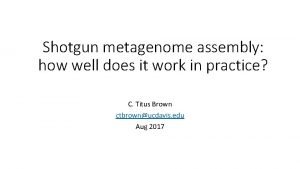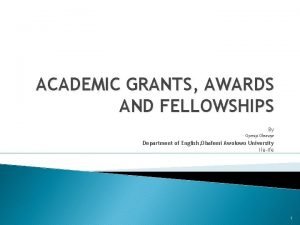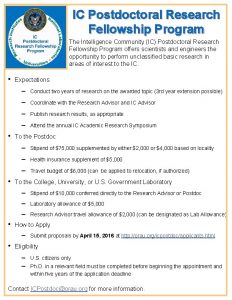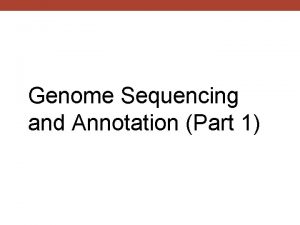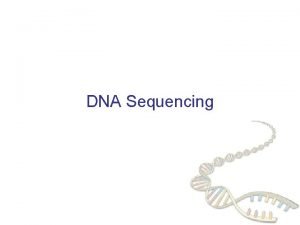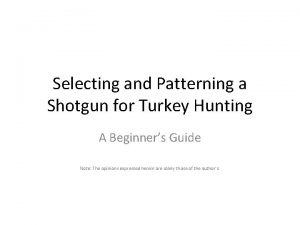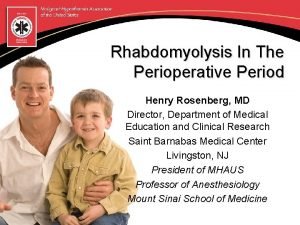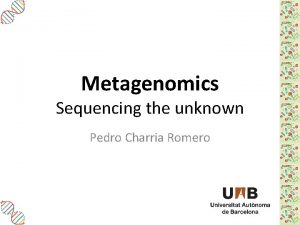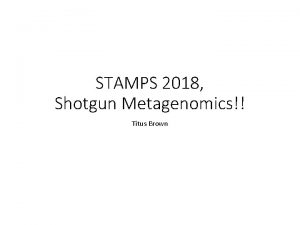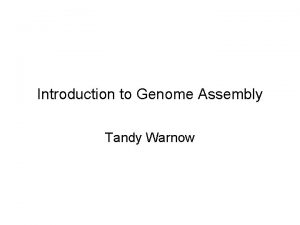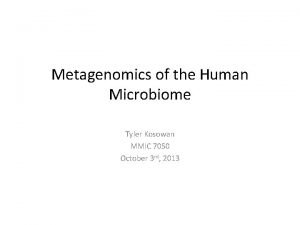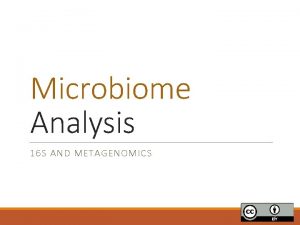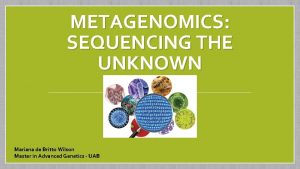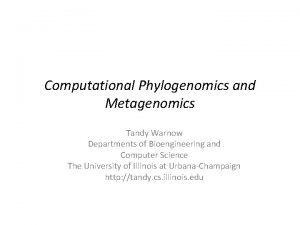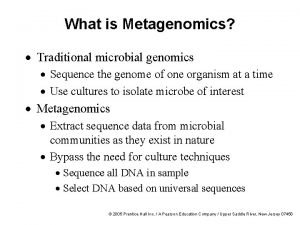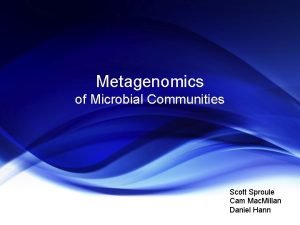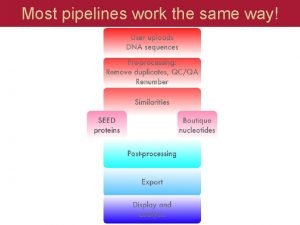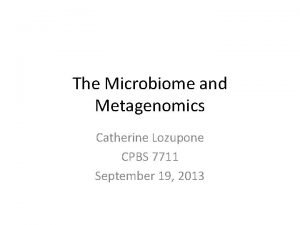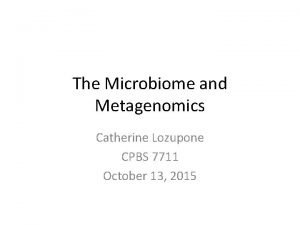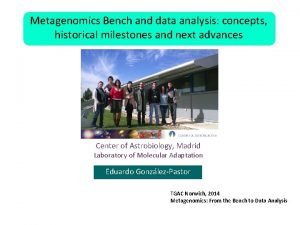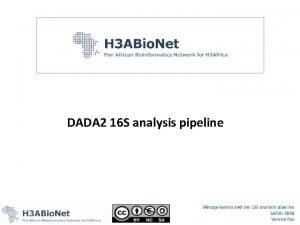An introduction to shotgun metagenomics Matt Hayward Postdoctoral
































- Slides: 32

An introduction to shotgun metagenomics Matt Hayward Postdoctoral Fellow in the Kwon lab, Ragon Institute of MGH, MIT and Harvard 12 th October 2018 Durban, SA mhayward 2@mgh. harvard. edu

My academic path Entomologist Microbiologist Computational biologist

Outline • What is shotgun metagenomic sequencing and how does it differ from 16 S? SSSSSSSSS • Interactive session • Case study: The microbiome of the female genital tract, inflammation and HIV acquisition risk

So why might we want to do metagenomics? www. grandomics. com http: //www. mississippi-metagenome-project. umn. edu/

What do we mean by shotgun and how does it differ from 16 S? Clean, blunt ended alignments Targeted excision of a single universal piece of DNA Microbial genome 16 S sequencing V 4: 255 bps

What do we mean by shotgun and how does it differ from 16 S? Alignment to reference sequences (indels, gaps…) or de novo assembly Microbial genome Non-targeted sequencing of DNA fragments Shotgun (WGS) sequencing

16 S Benefits of 16 S Shotgun A single taxonomic unit Random genome fragments Reagent contamination Reagent and human contamination 20, 000 reads is good 60, 000 reads is OK Cheap Very expensive Analysis is standardised Analysis is bespoke Analysis on PC Analysis on Computing Cluster Microbial $18 genome Shotgun Microbial $300 genome Python R Perl C

Shotgun achieves higher taxonomic resolution then 16 s Kingdom 16 s (QIIME 1) Shotgun Phylum Class Order Family Genus Species Sub-species Strain Bacterial taxon associations Universal Functions 16 s (ASVs) Person specific strains Strain tracking Functional inference

Why does this matter? (metabolism) Salmonella enterica subspecies enterica Limit of 16 s • There is a lot of functional diversity below the species-level • Metabolism matters when designing probiotics and prebiotics Hayward et al 2013 Hayward et al 2015

Why does this matter? (virulence) Salmonella enterica subspecies enterica serovar Derby L 1 L 2 Limit of 16 s L 1 L 2 Hayward et al 2016 Hayward et al 2014

Summary to part 1 If you are looking for microbial associations your samples have a lot of contamination And you have limited funds/computational resources If you are looking to make functional associations Track strains Explore functional diversity SSSS

Interactive session: From reads to results in just 1. 5 hours

Aims Using publicly available shotgun metagenome sequences: • Determine the species composition of these samples • Produce an abundance table • Visualise the results

Data • Stool metagenomic sequences • 30 samples from 30 healthy North Americans • Reads were quality trimmed • Human reads were removed by mapping to the human genome Human Microbiome Project HMP, Nature 2012

Python • All my scripts are written in either Python or R • Python is another language much like R and Unix (though much friendlier) • Here are some resources to begin your journey: http: //mechanicalmooc. org/ https: //pythonforbiologists. com/ https: //www. codecademy. com/catalog/language/python https: //www. datacamp. com/

Open Rmarkdown (Rmd)

Set working directory

Before Make a folder structure Sequences are in the temp_sequences directory Click this 1. 3. After “sample_file” contains a list of the sample names 2. Rmd works out the language Each sample now has it’s own folder and it’s sequences have been moved in to it

The metaphlan 2 approach to taxonomic profiling • Metaphlan 2 is the leading method for identifying the microbial composition of shotgun metagenome samples • It can identify microbes at all taxonomic levels from Kingdom down to subspecies • Metaphlan 2 is reference dependent • A genome must exist for a microbe to be identified in a sample

The reference (included with metaphlan 2): Species specific marker genes • Identify a set of genes that are unique to a species Species specific P. bivia is opr P. c s nsen 3 ecoie im P. Stp i Genus specific Non-specific (core) Fake data!!!!!

Step 1) Map reads to species specific marker genes Sample 1 (reads) Keep all genes with at least one uniquely mapped read Species A Species B Species C Species D

Step 2): Determine taxon abundance (at desired level) Order abund: 5 + 3 + 4 + 8 + 9 + 6 = 35 reads Family abund: 8 + 9 + 6 = 23 reads Genus abund: 6 + 9 = 15 reads Species abund: 6 reads 5 3 4 8 9 6 Number of reads mapping to species-specific genes

To do this when you get home: To download metaphlan 2 and all it’s dependencies: 1) Install conda https: //conda. io/miniconda. html 2) Install Metaphlan 2 (Bowtie 2 will come with it), run in the command prompt: conda install -c bioconda metaphlan 2

Taxonomic profiling: 1) map reads to marker genes 1. 2. Run the script Note: Looping through all the samples Note: Fill in the sample name and send to BASH

This is why we use loops You’d have to type all 30 jobs out

Bowtie 2 console output (about 5 mins) All this output relates to one sample Pretty easy to understand. We won’t need any of this info later!

Taxonomic profiling: 2) Summarise species abundances (metaphlan 2) 1) Open script 2) Replace this command with this one 3) Run the script (there will be no output printed to the console!)

Questions and coffee break 30 mins!

Taxonomic profiling: 3) Make a species abundance table (bespoke) Run make. Metaphlan 2 Tab. py Species abundances are only returned when seen, since metaphlan 2 doesn’t fill in 0 we have to do it ourselves for each sample

Data analysis and visualisation: Quick and easy (20 mins) 2) Now you are all Rmarkdown pros run through this script, read the comments and take a quick look at the plots 1)

If you want to do this again, this is probably not the way to do it! • I only gave you 0. 03% of a full sequence file (20, 000 reads) and we ran only one at a time, to do this for a full sample (60, 000 reads) will take 10 s of hours and to do it for all 30 will take weeks. • For efficient and effective analysis you will need to use a high performance computing cluster wherein you can submit multiple jobs in parallel with huge amounts of RAM and multiple cores

Questions and coffee break 15 mins!
 Oklahoma gang signs
Oklahoma gang signs Metagenomics
Metagenomics 1868 hayward earthquake
1868 hayward earthquake Hayward fault map
Hayward fault map Denise hayward
Denise hayward Admiral thomas hayward
Admiral thomas hayward Trivantage hayward
Trivantage hayward Geoff hayward
Geoff hayward Canada goose hayward
Canada goose hayward British academy postdoctoral fellowship
British academy postdoctoral fellowship Henry wellcome fellowship
Henry wellcome fellowship Leverhulme mid career fellowship
Leverhulme mid career fellowship Aobr postdoctoral training
Aobr postdoctoral training Tetfund postdoctoral fellowship
Tetfund postdoctoral fellowship National intelligence postdoctoral grant
National intelligence postdoctoral grant Human frontiers postdoctoral fellowship
Human frontiers postdoctoral fellowship Epsrc fellowships
Epsrc fellowships Rutherford postdoctoral fellowship
Rutherford postdoctoral fellowship Newton international fellowship success rate
Newton international fellowship success rate Sir henry wellcome postdoctoral fellowship
Sir henry wellcome postdoctoral fellowship The power i offense
The power i offense 870 p
870 p Beveling phenomenon
Beveling phenomenon Hierarchical shotgun sequencing vs whole genome
Hierarchical shotgun sequencing vs whole genome Hierarchical shotgun sequencing vs whole genome
Hierarchical shotgun sequencing vs whole genome Hierarchical shotgun sequencing vs whole genome
Hierarchical shotgun sequencing vs whole genome Patterning a shotgun for turkey
Patterning a shotgun for turkey Rail gun egun
Rail gun egun Smoothening of the inner surface of the gun barrel:
Smoothening of the inner surface of the gun barrel: Matt liotta
Matt liotta If scenario - jessica
If scenario - jessica Matt carver sai
Matt carver sai Dr rosenberg henry
Dr rosenberg henry

